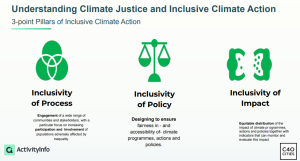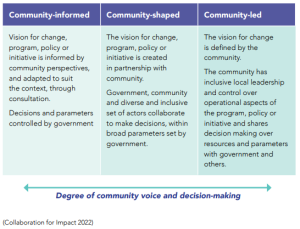
(Source: Activity Info, C40 Cities)
(Source: Baryulgil & Malabugilmah Community-led Resilience Team)
1. Supporting community-led programs for disaster preparedness
Lessons from the report Community-led Responses to Climate Change: Discovering Conditions for Equity and Social Justice
The increasing impacts of climate change highlight the need for community resilience, prompting a rethinking of how diverse communities are supported in their responses. This report, based on the Climate Discovery Project, explores community-led actions on climate change in Australia, focusing on social justice and equity. It examines how climate change perpetuates inequity, identifies ways to strengthen community responses, and reviews systemic interventions to promote equity and collective action. Insights were drawn from a review of studies and interviews across various regions that highlight barriers and opportunities. The report offers recommendations for collective learning, sustainable finance, and collaborative governance to support community-led climate actions and address inequities.
Community agency
In this report, community agency means how much community members are involved in decision-making and actions within traditional emergency management responses.

Barriers:
- Lack of collaborative structures connecting formal and informal response efforts
- Community knowledge and diverse experiences not recognised
- Decision-making and resourcing
- Institutional and Structural Inequities
Opportunities:
Collective learning systems at multiple scales. There is an opportunity to bring together various actors for collective learning and action on systemic issues.
- Climate injustice requires collaborative action across all levels, including individuals, community members, cultural leaders, industry, service agencies, philanthropic, and government bodies.
- It’s crucial to include diverse voices, especially those marginalised due to structural inequities, in climate change adaptation and planning.
- Coordinated, community-scale organisations enhance disaster response, recovery, and resilience efforts.
- Establishing collective learning systems across different scales and sectors can build new relationships, foster trust, and enable knowledge sharing.
- These systems can facilitate shared decision-making, create networks for data sharing, and shift power dynamics for better accountability.
- Collective learning and action at local, regional, and national levels can support community-wide dialogue and planning for climate impacts.
- Supporting selected communities with independent third-party facilitation can help include a broad range of voices, share perspectives, and identify priorities.
Further reading: Collaboration for Impact.
Further read: Care Through Disaster.
Pilot new models of sustainable and flexible investment in community-led approaches to climate change
- New ways to fund sustainable, place-based, community-led activities must be tested.
- Climate change impacts are increasing, leading to a growing demand for support that governments cannot fully meet.
- There is a need to explore sustainable models for investing in community-led climate change and resilience efforts.
- Interviewees highlighted the need for flexible, community-controlled funding models and resources.
- Funding should be time-flexible, needs-based post-disaster, and allocated based on community priorities.
- Non-prescriptive funding for recovery and resilience projects can support creativity and inclusivity.
- Community members and organisations want to manage investments directly for equitable outcomes, supporting local emergency response and resilience based on their own strengths and needs.
- There is a call for funding to support trauma-informed processes, accessible information, skill development for local leaders, resourcing unpaid essential work, and coordinated community responses.
- Investments should also focus on social connections, access to capital for social assets, and resources for community intervention and infrastructure.
- Piloting new financing mechanisms with select communities at different levels of readiness could help develop effective place-based investment models.
Support the establishment of collaborative governance structures
- Diverse voices need to be included in decision-making around climate action, recovery, response, and resilience efforts.
- Collaborative governance involves structures and processes that enable coordination across different organisations and sectors toward a common goal.
- Implementing collaborative governance can transform relational dynamics and address power imbalances in current decision-making processes.
- Research highlights the need for agile and flexible governance arrangements to respond quickly to emerging needs.
- Establishing standing committees and community-endorsed frameworks can formally include community leaders as key partners in disaster response, recovery, and resilience policy.
- Collaborative governance can support community decision-making about resource allocation and ownership, as well as shared decision-making between communities, service sectors, and government agencies.
- For Aboriginal and Torres Strait Islander communities, long-term investment and decision-making pathways are needed to address their ongoing exclusion from policy-making and recognise their unique experiences and priorities.
- Supporting communities with local governance structures prioritising equity requires adequate resources and support, cultural intelligence, and trauma-informed, inclusive, and anti-oppressive practices.
Lessons from the report Supporting Community-Led Program to Disaster Preparedness
Recommendations
- Community-led approaches to resilience building must be moved from the periphery of emergency management to the centre.
- New structures and processes for collaboration and decision-making that locate community members, emergency management agencies, local government, community services organisations, local groups and businesses as equal contributors should be established.
- Shared responsibility must translate into increased and shared support for sustained community-led resilience building. Irregular support and one-off funding do not support this work.
- Building disaster resilience needs to reflect the experience of communities where preparedness, response, and recovery are fluid and sometimes simultaneous.
- The time between disasters is an ideal opportunity to engage communities in complex discussions and hear their ideas.
- To support resilience building, meaningful locally generated information and communication (beyond alerts and warnings) provide more robust protections against misinformation than generic and reductive messages framing communities as passive recipients
- Cross-sector and cross-community agreement that community-led approaches are valuable must be matched with cross-sector and cross-community investment.
- Community-led disaster resilience building occurs within complex systems. It thrives when an array of networks, relationships, partnerships and alliances work together in lateral rather than hierarchical way.s
- This research points to the enormous potential of supporting negotiated partnerships between self-organising systems in local communities and community-based organisations to build disaster resilience.
2. Care through disaster
Care through Disaster -Women’s Health Goulburn North East, Vict. State Gov., Australia reMade
Women’s Health Goulburn North East has published a report on Caring through Disaster to help better understand what is needed to keep our communities safe and thriving in a disaster-prone world.
“Care is our individual and common ability to provide the political, social, material and emotional conditions that allow the vast majority of people and living creatures on the planet to thrive – along with the planet itself.”
For people to care for each other and be cared for during disasters, they need three things:
- They need to be SEEN (recognized in their communities and by government authorities within strong, connected communities).
- They need to be SAFE (through disaster prevention and mitigation, access to safe places, and accurate, timely, and accessible information).
- They need to be SUPPORTED (ready to support each other before, during, and after disasters).
In part one of this report, each of these needs is explained, and a story is provided that shows how it would look and feel if these needs were met during a disaster.
Part two discusses what these findings mean. It is argued that strong, connected communities are crucial not just on their own but as essential infrastructure for preparing for, surviving, and recovering from disasters. The report loos at how building these communities is often gendered, overlooked, and undervalued. It also explores additional solutions, including new policies to help people survive and thrive in a world facing more disasters.
3. Understanding climate change impacts on social injustices
In many cases, climate change and disaster preparedness initiatives adhere to a standardised approach, disregarding the diverse needs and consequences experienced by various communities. This resource emphasises the significance of intersectionality in disaster preparedness and resilience efforts, shedding light on how disasters disproportionately affect historically marginalised groups and exacerbate pre-existing social inequalities. Through collaboration and co-design, it aims to address these disparities and ensure that response strategies are inclusive and effective for all individuals and communities.
Visit: Climate Change Impacts on Social Injustices
4. Inclusivity and intersectionality in disaster preparedness
4.1 Diversity in Disaster
Australian Journal of Emergency Management – Monograph
“In every society, there are power dynamics, and
groups that may experience exclusion, making them
more vulnerable to hazards and other threats.”
Turnbull & Moriniere, 2017, p. 6 in Monograph
A major focus for improving disaster resilience in all communities is sharing knowledge and information, especially using online tools. Various resources are highlighted in the Monograph report, such as planning for people with disabilities and chronic health issues, key factors for successful community projects, and promoting diversity and inclusion in emergency management through different communication channels.
“The need for effective disaster risk management is greater than ever and demands a change in the way we work. As agreed in the Sendai framework for disaster risk reduction in 2015 and 2030, we must go beyond preparedness and response so that people do not remain in a vicious cycle of poverty and disaster. We must be inclusive and prioritise the needs of the most vulnerable. We must empower communities to plan and drive change and reinforce governments’ responsibility to provide their people with a protective and enabling environment”.
Turnbull & Moriniere, 2017, p. 3 in Monograph
4.2 Guidelines for just and inclusive approaches to emergency relief and disaster response
The Gender and Emergency Management Guidelines include background information, principles and actions for consideration within the following sections:
- Supporting community gender equity and diversity
- Gender-sensitive communication and messaging
- Addressing domestic violence during and following an emergency
Gender and Emergency Management Action Checklist (Gender and Disaster Australia)
Having a Seat at the Table: disaster and disability (Australian Disaster Resilience Knowledge Hub)
4.3 Disaster Risk Reduction (DRR) dynamics – Supporting inclusive disaster risk reduction
This website provides a variety of resources, blogs, reports and presentations that can help better understand intersectionality in disaster risk reduction and how to integrate it.
Some of the topics are:
Report series on intersectionality, marginalised groups & disasters
Addendum – Early warning systems, AI, disasters & marginalised groups
Gender and sexual minorities: Health considerations in times of disaster
The importance of gender and sexual minorities in emergency management
#DRRLive debrief – Imagining a post-Sendai DRR
Artificial Intelligence, disasters & marginalised groups
Housing, disasters & LGBTQIA+ people
Invisible Again: Hyper-marginalised groups and disaster data
Animals, disasters & marginalised groups
A guide for the general public on using social media in times of crisis
No Natural Disasters – Changing the discourse of disaster reporting
The economic impacts of disasters on marginalised groups
5. Planning and preparing for community-led disaster recovery
Worksheets (NSW Council of Social Services)
These worksheets help organisations define their roles and strengths within disaster management and response. It poses relevant questions to help develop resilient networks that support staff and volunteers, develop robust referral and information sharing, and guidings to plan to work together.
Worksheets include:
Disaster recovery and resilience roles
Evaluating where you can contribute
Local and non-local organisations
Planning to work together
Building cross-organisation networks
Developing your contact directory
Developing robust consent, referral and information-sharing protocols
Planning to support staff and volunteers
Identifying and accessing practical resources
6. Developing resilience capacities: absorb, adapt, transform
(Source: Oxfam, Absorb, Adapt, Transform: Resilience Capacity, Oxfam)
While resilience capacity can be broadly defined, it’s essential to acknowledge that women, men, communities, and institutions will have their own perspectives and terminology for describing resilience and capacity. These distinct and individual viewpoints must be comprehended and incorporated into the planning, assessment, and appraisal of programs and initiatives.
Change is occurring rapidly in various aspects of our environment, agriculture, and politics, leading to suffering, instability, and unpredictability. Resilience involves bolstering the ability to proactively and positively navigate this change, aiming for a fair world devoid of poverty.
The Oxfam Framework for Resilient Development, outlined in “The Future is a Choice,” delineates three categories of resilience capacity: absorptive, adaptive, and transformative. These capacities must be strengthened to achieve resilient development outcomes, ensuring the realisation of rights and well-being despite shocks, pressures, and uncertainty.
While the development sector commonly uses the term “capacity,” Oxfam tends to conceptualise in terms of agency, empowerment, and choice. However, these terms—capacity, ability, agency, and choice—essentially convey similar meanings. In our resilience work, Oxfam employs the term “capacity” to facilitate better communication and collaboration within the development sector.
7. Climate change: adaptation justice indicators
The authors of the research paper Connecting Climate Justice and Adaptation Planning: An Adaptation Justice Index (S. Juhola et al. 2022) bring together what has been learned in previous research to make a fairness index for climate adaptation. This index looks at four fairness dimensions: recognition, distribution, procedures, and restoration. It helps analyse and compare different strategies and plans for dealing with climate change in various places and at different levels of government. Since planning for adaptation to climate change is still new, these results can be used to assess how fair adaptation plans are.
| Dimension of Justice | Indicators | Score |
|
1.1.The strategy acknowledges that adaptation needs are different across groups in society | |
| 1.2. The strategy acknowledges the impact of existing societal structures on vulnerable groups in adapting to the impacts of climate change | ||
| 1.3. The strategy acknowledges adaptation as a way to secure basic human rights | ||
| 2. Distributive Justice | 2.1. A risk mapping/assessment is conducted | |
| 2.2. There is a process for identifying vulnerable groups | ||
| 2.3. There is a process that assesses the distribution of benefits from adaptation | ||
| 2.4. There is a process that assesses how the costs of adaptation are divided | ||
| 2.5. The strategy identifies the possibility of the
distribution of negative impacts, i.e., maladaptation, of adaptation measures |
||
| 3. Procedural Justice | 3.1. Adaptation strategy details who participates in the strategy process | |
| 3.2. The adaptation strategy has involved participation during different phases of the process | ||
| 3.3. The strategy allocates responsibilities related to adaptation | ||
| 3.4. The adaptation strategy has a structured plan for participation in the implementation. | ||
| 3.5. The adaptation strategy has a plan for updating and evaluating the strategy | ||
| 4. Restorative Justice | 4.1. The strategy acknowledges the need to compensate for the diverging impacts of climate change | |
| 4.2. The strategy has compensation measures to deal with maladaptation | ||
| 4.3. The unequal distribution of resources for adaptation is compensated by redistribution |
(This table has been developed based on Connecting Climate Justice and Adaptation Planning: An adaptation justice index by S. Juhola et al. 2022)
Case study:
Creative, Community, Wellbeing and Resilience Hub (the Hub) project, run by Blackheath Area Neighbourhood Centre in Blackheath, New South Wales
The Hub’s goal is to support disaster preparation and recovery by offering creative, practical, and emotional support to the whole community. From January 2022 to June 2023, the Hub hosted events, workshops, and activities focused on social connections, practical help, education (like preparing properties for bushfire season), and overall well-being. This program was a response to recent natural disasters and the COVID-19 pandemic, aiming to prepare for future challenges. The report found that those who took part in the Hub’s activities felt more connected, involved in community events, and resilient. The Hub serves as a good example for community organisations in disaster preparation and recovery. It also highlighted the important work these organisations are doing and the need for more long-term funding to support their efforts.
(Source: The policy, research and practice areas informing the Hub model)
A key part of the Hub has been working with community partners to create and run its activities. The benefits of this approach include:
- Strengthening and expanding existing relationships.
- Forming new partnerships with the potential for long-term collaboration.
- Avoiding overlapping programmes, which can reduce attendance and create competition among providers.
- Making sure funding is used as effectively as possible.
- Allowing for more creative and flexible programme development.
- Helping people connect with other services and networks in the community.
Reflective questions for community service organisations
Based on the above content we have developed a set of reflective questions for Community Service Organisation to consider when engaging in Community-Led Disaster Preparedness.
- Supporting Community-Led Programs
- How can our organisation better involve the community in planning for disasters?
- What can we do to ensure that everyone in the community has a say in our disaster plans?
- What barriers do we face in recognising and working with the community, and how can we overcome them?
- Care through Disaster
- How can we make sure our community feels noticed, safe, and supported during disasters?
- What changes can we make to our disaster plans to include the principles of visibility, safety, and support?
- What can we learn from other care models to improve our disaster support?
- Understanding Climate Change Impacts on Social Injustices
- How does climate change affect different groups in our community, especially those who are already disadvantaged?
- What can we do to make sure our disaster plans are fair and address these social inequalities?
- How can we work better with affected groups to tackle these issues?
- Inclusivity and Intersectionality in Disaster Preparedness
- How can we ensure our disaster plans consider the needs of everyone, including those with disabilities or other vulnerabilities?
- What can we do to promote inclusivity and address power imbalances in our planning and response efforts?
- How can we use technology and communication tools to reach and engage with underrepresented groups?
- Planning and Preparing for Community-Led Disaster Recovery
- What roles and strengths does our organisation have in disaster recovery, and how can we make the most of them?
- How can we build and maintain effective partnerships to support disaster recovery?
- What key elements should we consider for sharing information and supporting our staff and volunteers?
- Developing Resilience Capacities: Absorb, Adapt, Transform
- How can we improve our organisation’s ability to handle changes and challenges from climate-related events?
- What specific actions can we take to help our community be better prepared for future disasters?
- How can we include different perspectives and terms in our resilience planning to make it more effective?
- Climate Change: Adaptation Justice Indicators
- How can we use fairness principles to assess and improve our disaster preparedness strategies?
- What indicators should we use to check if our adaptation policies are fair and effective?
- How can we ensure our strategies include support for those most affected by climate change?
Read more
RediCommunities – Workshops, Red Cross
Red Cross is working alongside communities to strengthen resilience and prepare for disaster.
Community Engagement for Disaster Resilience (Australian Disaster Resilience Handbook Collection)
Towards transformative climate justice – an emerging research agenda
Building resilience to the mental health impacts of climate change in rural Australia

